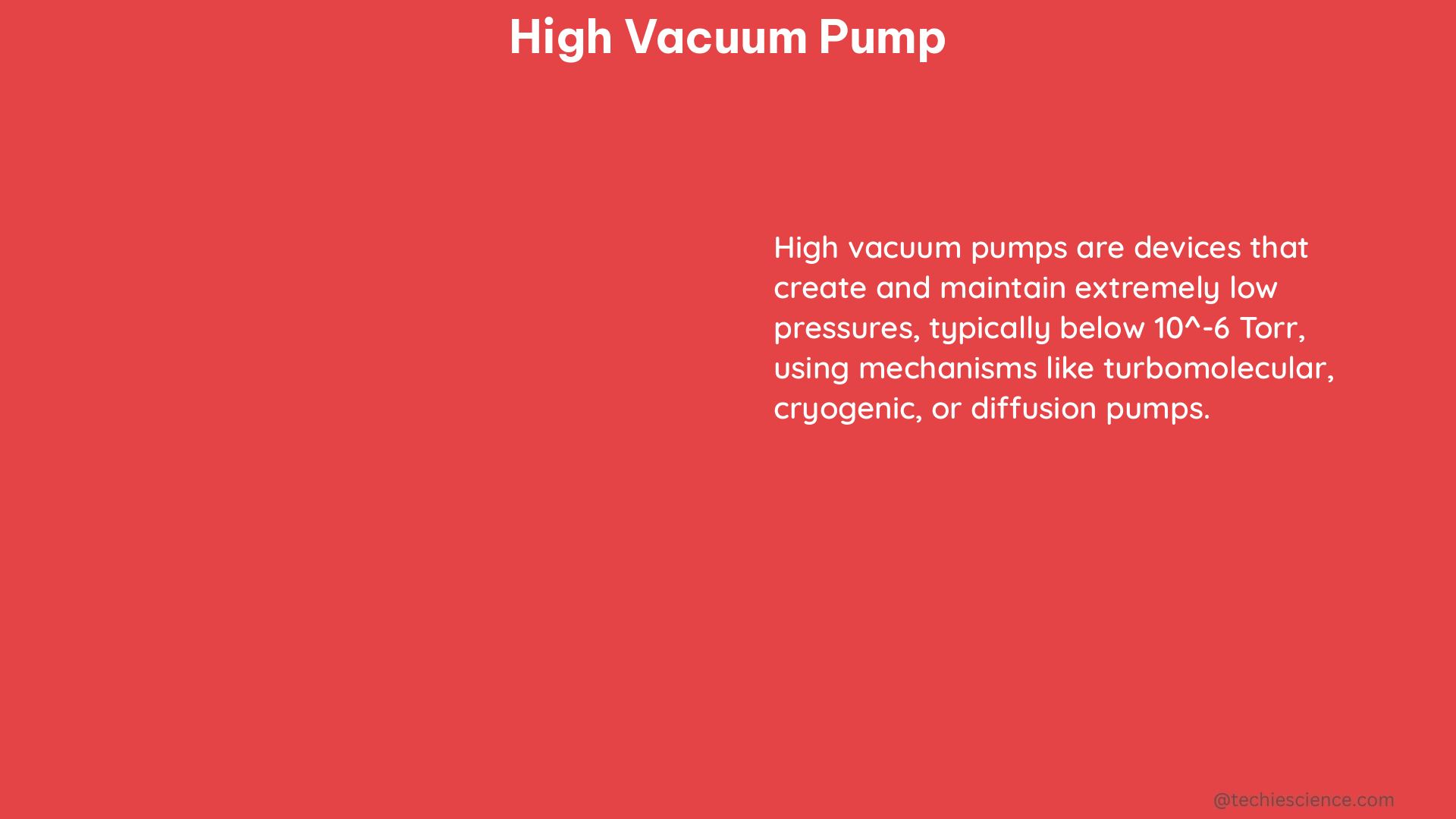High vacuum pumps are specialized devices designed to create and maintain extremely low-pressure environments, typically in the range of 1×10^-3 to 1×10^-9 Torr. These advanced pumps play a crucial role in a wide array of industries, from semiconductor manufacturing and scientific research to coating processes and cryogenic applications. In this comprehensive guide, we will delve into the intricate details of high vacuum pumps, exploring their key performance metrics, operating principles, and maintenance requirements to help you make informed decisions and achieve optimal results.
Understanding Vacuum Levels and Pumping Capabilities
The primary function of a high vacuum pump is to evacuate a given volume of gas, reducing the pressure within a system to extremely low levels. The vacuum levels achievable by these pumps are measured in Torr, a unit of pressure, with the lowest attainable pressure being 1×10^-9 Torr, or one billionth of a Torr. This level of vacuum is equivalent to just 1 micron (μm) of mercury (Hg), a testament to the remarkable performance of these specialized pumps.
To quantify the pumping capabilities of high vacuum pumps, we examine their pumping speed, which is measured in liters per second (L/s) or cubic feet per minute (cfm). This metric indicates the volume of gas that the pump can evacuate from the system per unit of time, allowing users to select the appropriate pump size for their specific application.
Compression Ratio and Flow Capacity

Another crucial parameter of high vacuum pumps is their compression ratio, which is the ratio of the inlet pressure to the outlet pressure. This ratio is a measure of the pump’s ability to compress gases and effectively remove them from the system. A higher compression ratio typically indicates a more efficient pump, capable of achieving lower ultimate pressures.
Closely related to the compression ratio is the flow capacity of a high vacuum pump, which represents the maximum volume of gas the pump can handle at a given vacuum level. This metric is expressed in cubic meters per hour (m³/h) or cubic feet per minute (cfm), and it is essential in selecting the right pump for a particular application, ensuring that the pump can effectively evacuate the required gas load.
Power Consumption and Operating Temperature
The power consumption of a high vacuum pump is an important consideration, as it directly impacts the operating costs and energy efficiency of the system. This parameter is measured in watts (W) or horsepower (hp), and it can vary significantly depending on the pump type, size, and the specific application.
Alongside power consumption, the operating temperature of a high vacuum pump is a crucial factor. These pumps are designed to operate within a specific temperature range, typically measured in degrees Celsius (°C) or Fahrenheit (°F), to maintain optimal performance and longevity. Exceeding the recommended operating temperature can lead to premature wear, reduced efficiency, and even pump failure.
Achieving the Ultimate Pressure and Pump-Down Time
The ultimate pressure of a high vacuum pump is the lowest pressure it can achieve in a given system, and it is measured in Torr or Pascals (Pa). This parameter is essential in determining the suitability of a pump for a particular application, as different processes may require different levels of vacuum.
Closely related to the ultimate pressure is the pump-down time, which is the time it takes to evacuate a given volume of gas from the system to the desired vacuum level. This metric is measured in minutes or seconds and is influenced by factors such as the pump’s pumping speed, the system’s volume, and the initial pressure.
Maintenance Intervals and Noise Levels
Proper maintenance is crucial for the long-term performance and reliability of high vacuum pumps. The maintenance intervals of these pumps are the recommended periods between servicing or replacing the pump’s components, and they are typically measured in hours of operation or calendar time.
Finally, the noise levels of high vacuum pumps are an important consideration, especially in applications where noise pollution is a concern. The noise levels are measured in decibels (dB) and can vary significantly depending on the pump type, size, and design.
Selecting the Right High Vacuum Pump for Your Application
When choosing a high vacuum pump, it is essential to carefully consider the specific requirements of your application. Factors such as the desired vacuum level, pumping speed, compression ratio, flow capacity, power consumption, operating temperature, and maintenance intervals should all be taken into account to ensure the optimal performance and efficiency of your system.
By understanding the technical details and quantifiable data points presented in this comprehensive guide, you can make informed decisions, select the most suitable high vacuum pump, and achieve the extreme vacuum levels required for your critical processes.
References
- Fundamentals of Vacuum Technology
- How to Measure Vacuum: Methods, Units and Scales | TAWI
- High, Ultra & Extreme High Vacuum Generation
- Vacuum Pump Selection Guide
- Understanding Vacuum Pump Performance Specifications
- Vacuum Pump Maintenance and Troubleshooting
- Noise Levels of Vacuum Pumps

The lambdageeks.com Core SME Team is a group of experienced subject matter experts from diverse scientific and technical fields including Physics, Chemistry, Technology,Electronics & Electrical Engineering, Automotive, Mechanical Engineering. Our team collaborates to create high-quality, well-researched articles on a wide range of science and technology topics for the lambdageeks.com website.
All Our Senior SME are having more than 7 Years of experience in the respective fields . They are either Working Industry Professionals or assocaited With different Universities. Refer Our Authors Page to get to know About our Core SMEs.